Nursing Leadership: Transformational, Congruent, and Aesthetic Styles
VerifiedAdded on 2023/06/14
|7
|2123
|352
Essay
AI Summary
This essay explores various leadership theories and frameworks relevant to contemporary clinical leadership in nursing. It discusses transformational leadership, congruent leadership, and aesthetic leadership, highlighting their strengths and limitations in the context of clinical practice. The essay argues that while transformational leadership has been dominant, aesthetic leadership offers a valuable alternative by incorporating art and aesthetics into nursing practice and addressing the shortcomings of other models. It emphasizes the importance of considering multiple leadership styles to navigate the complexities of modern healthcare organizations and improve patient outcomes. The paper concludes that embracing aesthetic leadership can enhance the effectiveness of clinical leaders by recognizing the unique expertise and perspectives of nurses, ultimately leading to progressive results for both caregivers and patients. Desklib offers this essay as part of its collection of solved assignments for students.
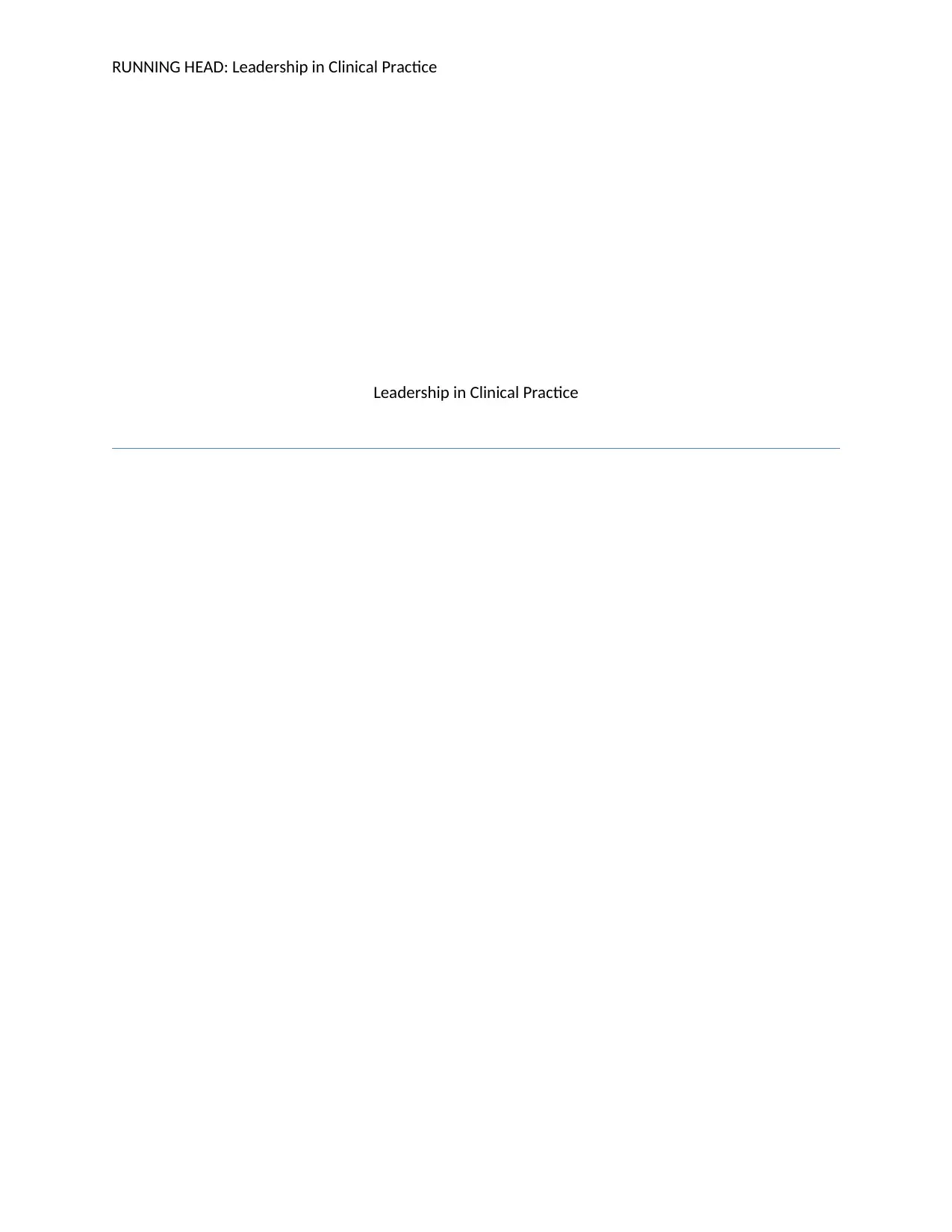
RUNNING HEAD: Leadership in Clinical Practice
Leadership in Clinical Practice
Leadership in Clinical Practice
Paraphrase This Document
Need a fresh take? Get an instant paraphrase of this document with our AI Paraphraser
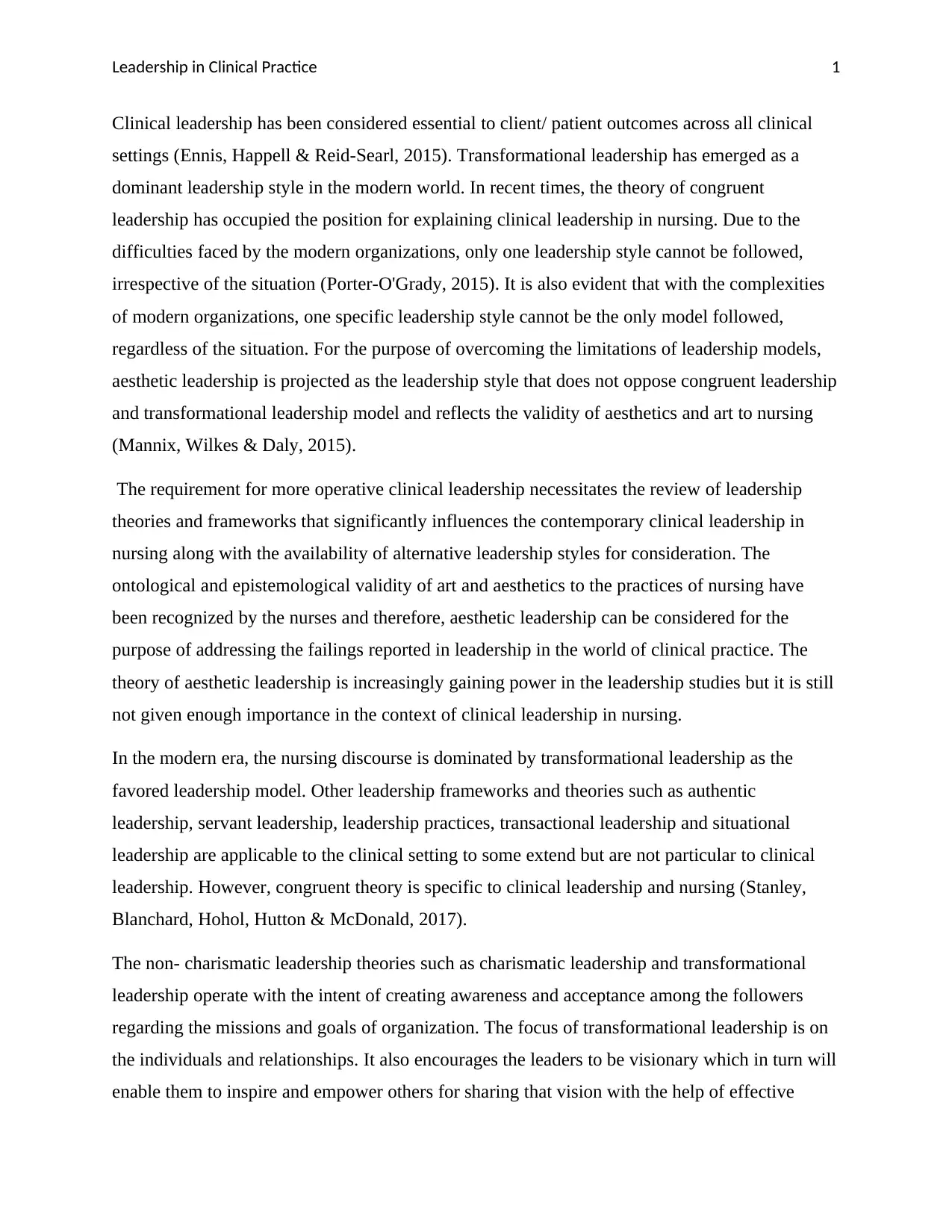
Leadership in Clinical Practice 1
Clinical leadership has been considered essential to client/ patient outcomes across all clinical
settings (Ennis, Happell & Reid‐Searl, 2015). Transformational leadership has emerged as a
dominant leadership style in the modern world. In recent times, the theory of congruent
leadership has occupied the position for explaining clinical leadership in nursing. Due to the
difficulties faced by the modern organizations, only one leadership style cannot be followed,
irrespective of the situation (Porter-O'Grady, 2015). It is also evident that with the complexities
of modern organizations, one specific leadership style cannot be the only model followed,
regardless of the situation. For the purpose of overcoming the limitations of leadership models,
aesthetic leadership is projected as the leadership style that does not oppose congruent leadership
and transformational leadership model and reflects the validity of aesthetics and art to nursing
(Mannix, Wilkes & Daly, 2015).
The requirement for more operative clinical leadership necessitates the review of leadership
theories and frameworks that significantly influences the contemporary clinical leadership in
nursing along with the availability of alternative leadership styles for consideration. The
ontological and epistemological validity of art and aesthetics to the practices of nursing have
been recognized by the nurses and therefore, aesthetic leadership can be considered for the
purpose of addressing the failings reported in leadership in the world of clinical practice. The
theory of aesthetic leadership is increasingly gaining power in the leadership studies but it is still
not given enough importance in the context of clinical leadership in nursing.
In the modern era, the nursing discourse is dominated by transformational leadership as the
favored leadership model. Other leadership frameworks and theories such as authentic
leadership, servant leadership, leadership practices, transactional leadership and situational
leadership are applicable to the clinical setting to some extend but are not particular to clinical
leadership. However, congruent theory is specific to clinical leadership and nursing (Stanley,
Blanchard, Hohol, Hutton & McDonald, 2017).
The non- charismatic leadership theories such as charismatic leadership and transformational
leadership operate with the intent of creating awareness and acceptance among the followers
regarding the missions and goals of organization. The focus of transformational leadership is on
the individuals and relationships. It also encourages the leaders to be visionary which in turn will
enable them to inspire and empower others for sharing that vision with the help of effective
Clinical leadership has been considered essential to client/ patient outcomes across all clinical
settings (Ennis, Happell & Reid‐Searl, 2015). Transformational leadership has emerged as a
dominant leadership style in the modern world. In recent times, the theory of congruent
leadership has occupied the position for explaining clinical leadership in nursing. Due to the
difficulties faced by the modern organizations, only one leadership style cannot be followed,
irrespective of the situation (Porter-O'Grady, 2015). It is also evident that with the complexities
of modern organizations, one specific leadership style cannot be the only model followed,
regardless of the situation. For the purpose of overcoming the limitations of leadership models,
aesthetic leadership is projected as the leadership style that does not oppose congruent leadership
and transformational leadership model and reflects the validity of aesthetics and art to nursing
(Mannix, Wilkes & Daly, 2015).
The requirement for more operative clinical leadership necessitates the review of leadership
theories and frameworks that significantly influences the contemporary clinical leadership in
nursing along with the availability of alternative leadership styles for consideration. The
ontological and epistemological validity of art and aesthetics to the practices of nursing have
been recognized by the nurses and therefore, aesthetic leadership can be considered for the
purpose of addressing the failings reported in leadership in the world of clinical practice. The
theory of aesthetic leadership is increasingly gaining power in the leadership studies but it is still
not given enough importance in the context of clinical leadership in nursing.
In the modern era, the nursing discourse is dominated by transformational leadership as the
favored leadership model. Other leadership frameworks and theories such as authentic
leadership, servant leadership, leadership practices, transactional leadership and situational
leadership are applicable to the clinical setting to some extend but are not particular to clinical
leadership. However, congruent theory is specific to clinical leadership and nursing (Stanley,
Blanchard, Hohol, Hutton & McDonald, 2017).
The non- charismatic leadership theories such as charismatic leadership and transformational
leadership operate with the intent of creating awareness and acceptance among the followers
regarding the missions and goals of organization. The focus of transformational leadership is on
the individuals and relationships. It also encourages the leaders to be visionary which in turn will
enable them to inspire and empower others for sharing that vision with the help of effective
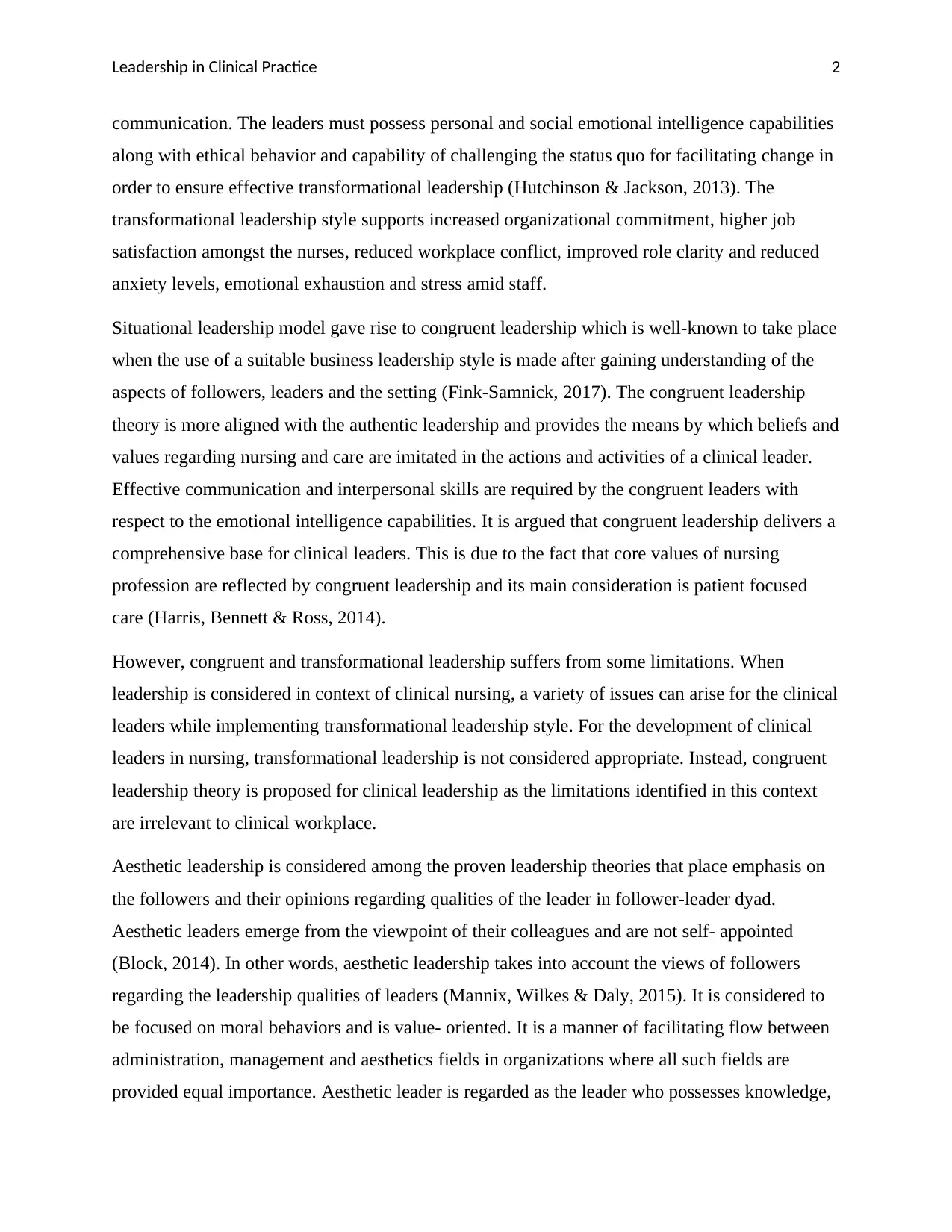
Leadership in Clinical Practice 2
communication. The leaders must possess personal and social emotional intelligence capabilities
along with ethical behavior and capability of challenging the status quo for facilitating change in
order to ensure effective transformational leadership (Hutchinson & Jackson, 2013). The
transformational leadership style supports increased organizational commitment, higher job
satisfaction amongst the nurses, reduced workplace conflict, improved role clarity and reduced
anxiety levels, emotional exhaustion and stress amid staff.
Situational leadership model gave rise to congruent leadership which is well-known to take place
when the use of a suitable business leadership style is made after gaining understanding of the
aspects of followers, leaders and the setting (Fink-Samnick, 2017). The congruent leadership
theory is more aligned with the authentic leadership and provides the means by which beliefs and
values regarding nursing and care are imitated in the actions and activities of a clinical leader.
Effective communication and interpersonal skills are required by the congruent leaders with
respect to the emotional intelligence capabilities. It is argued that congruent leadership delivers a
comprehensive base for clinical leaders. This is due to the fact that core values of nursing
profession are reflected by congruent leadership and its main consideration is patient focused
care (Harris, Bennett & Ross, 2014).
However, congruent and transformational leadership suffers from some limitations. When
leadership is considered in context of clinical nursing, a variety of issues can arise for the clinical
leaders while implementing transformational leadership style. For the development of clinical
leaders in nursing, transformational leadership is not considered appropriate. Instead, congruent
leadership theory is proposed for clinical leadership as the limitations identified in this context
are irrelevant to clinical workplace.
Aesthetic leadership is considered among the proven leadership theories that place emphasis on
the followers and their opinions regarding qualities of the leader in follower-leader dyad.
Aesthetic leaders emerge from the viewpoint of their colleagues and are not self- appointed
(Block, 2014). In other words, aesthetic leadership takes into account the views of followers
regarding the leadership qualities of leaders (Mannix, Wilkes & Daly, 2015). It is considered to
be focused on moral behaviors and is value- oriented. It is a manner of facilitating flow between
administration, management and aesthetics fields in organizations where all such fields are
provided equal importance. Aesthetic leader is regarded as the leader who possesses knowledge,
communication. The leaders must possess personal and social emotional intelligence capabilities
along with ethical behavior and capability of challenging the status quo for facilitating change in
order to ensure effective transformational leadership (Hutchinson & Jackson, 2013). The
transformational leadership style supports increased organizational commitment, higher job
satisfaction amongst the nurses, reduced workplace conflict, improved role clarity and reduced
anxiety levels, emotional exhaustion and stress amid staff.
Situational leadership model gave rise to congruent leadership which is well-known to take place
when the use of a suitable business leadership style is made after gaining understanding of the
aspects of followers, leaders and the setting (Fink-Samnick, 2017). The congruent leadership
theory is more aligned with the authentic leadership and provides the means by which beliefs and
values regarding nursing and care are imitated in the actions and activities of a clinical leader.
Effective communication and interpersonal skills are required by the congruent leaders with
respect to the emotional intelligence capabilities. It is argued that congruent leadership delivers a
comprehensive base for clinical leaders. This is due to the fact that core values of nursing
profession are reflected by congruent leadership and its main consideration is patient focused
care (Harris, Bennett & Ross, 2014).
However, congruent and transformational leadership suffers from some limitations. When
leadership is considered in context of clinical nursing, a variety of issues can arise for the clinical
leaders while implementing transformational leadership style. For the development of clinical
leaders in nursing, transformational leadership is not considered appropriate. Instead, congruent
leadership theory is proposed for clinical leadership as the limitations identified in this context
are irrelevant to clinical workplace.
Aesthetic leadership is considered among the proven leadership theories that place emphasis on
the followers and their opinions regarding qualities of the leader in follower-leader dyad.
Aesthetic leaders emerge from the viewpoint of their colleagues and are not self- appointed
(Block, 2014). In other words, aesthetic leadership takes into account the views of followers
regarding the leadership qualities of leaders (Mannix, Wilkes & Daly, 2015). It is considered to
be focused on moral behaviors and is value- oriented. It is a manner of facilitating flow between
administration, management and aesthetics fields in organizations where all such fields are
provided equal importance. Aesthetic leader is regarded as the leader who possesses knowledge,
⊘ This is a preview!⊘
Do you want full access?
Subscribe today to unlock all pages.

Trusted by 1+ million students worldwide
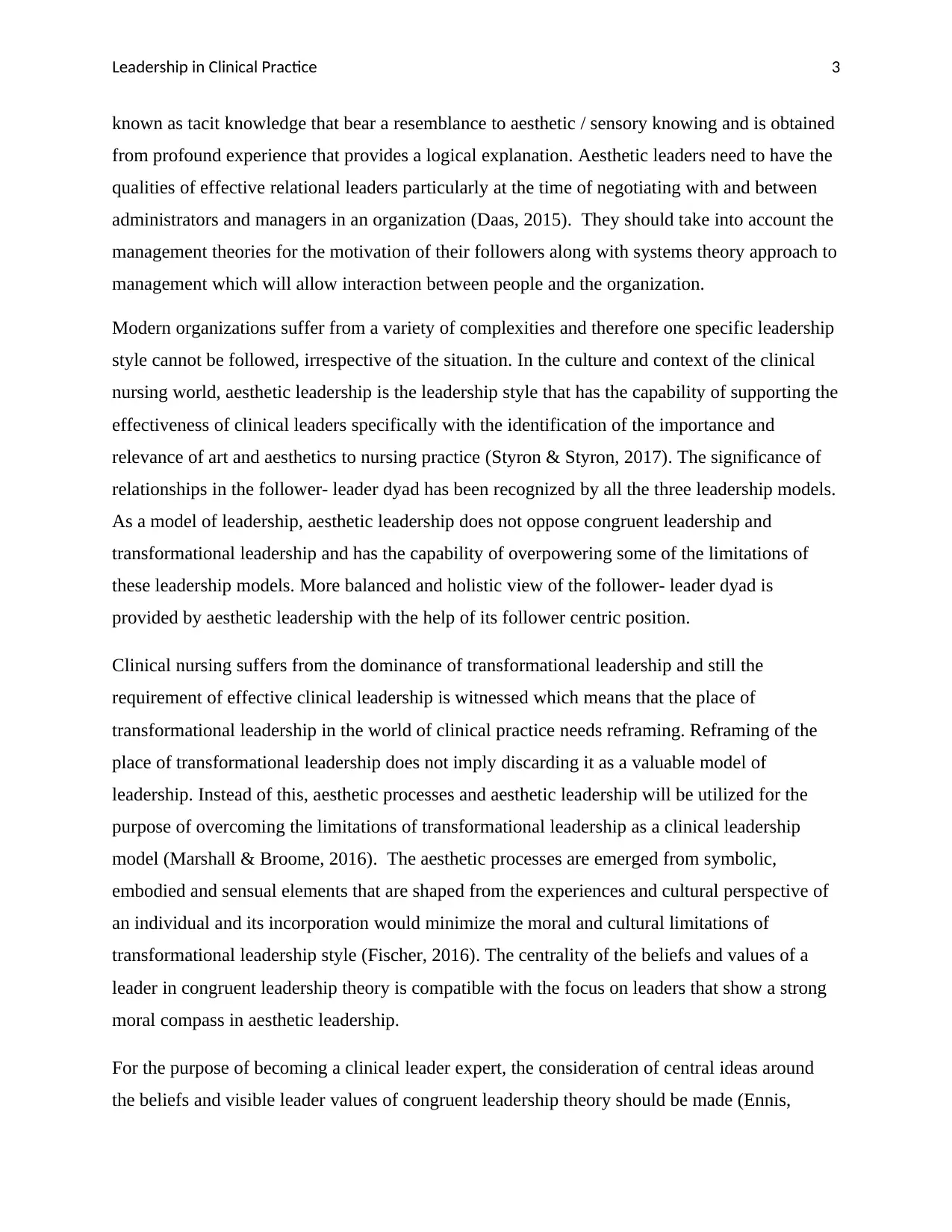
Leadership in Clinical Practice 3
known as tacit knowledge that bear a resemblance to aesthetic / sensory knowing and is obtained
from profound experience that provides a logical explanation. Aesthetic leaders need to have the
qualities of effective relational leaders particularly at the time of negotiating with and between
administrators and managers in an organization (Daas, 2015). They should take into account the
management theories for the motivation of their followers along with systems theory approach to
management which will allow interaction between people and the organization.
Modern organizations suffer from a variety of complexities and therefore one specific leadership
style cannot be followed, irrespective of the situation. In the culture and context of the clinical
nursing world, aesthetic leadership is the leadership style that has the capability of supporting the
effectiveness of clinical leaders specifically with the identification of the importance and
relevance of art and aesthetics to nursing practice (Styron & Styron, 2017). The significance of
relationships in the follower- leader dyad has been recognized by all the three leadership models.
As a model of leadership, aesthetic leadership does not oppose congruent leadership and
transformational leadership and has the capability of overpowering some of the limitations of
these leadership models. More balanced and holistic view of the follower- leader dyad is
provided by aesthetic leadership with the help of its follower centric position.
Clinical nursing suffers from the dominance of transformational leadership and still the
requirement of effective clinical leadership is witnessed which means that the place of
transformational leadership in the world of clinical practice needs reframing. Reframing of the
place of transformational leadership does not imply discarding it as a valuable model of
leadership. Instead of this, aesthetic processes and aesthetic leadership will be utilized for the
purpose of overcoming the limitations of transformational leadership as a clinical leadership
model (Marshall & Broome, 2016). The aesthetic processes are emerged from symbolic,
embodied and sensual elements that are shaped from the experiences and cultural perspective of
an individual and its incorporation would minimize the moral and cultural limitations of
transformational leadership style (Fischer, 2016). The centrality of the beliefs and values of a
leader in congruent leadership theory is compatible with the focus on leaders that show a strong
moral compass in aesthetic leadership.
For the purpose of becoming a clinical leader expert, the consideration of central ideas around
the beliefs and visible leader values of congruent leadership theory should be made (Ennis,
known as tacit knowledge that bear a resemblance to aesthetic / sensory knowing and is obtained
from profound experience that provides a logical explanation. Aesthetic leaders need to have the
qualities of effective relational leaders particularly at the time of negotiating with and between
administrators and managers in an organization (Daas, 2015). They should take into account the
management theories for the motivation of their followers along with systems theory approach to
management which will allow interaction between people and the organization.
Modern organizations suffer from a variety of complexities and therefore one specific leadership
style cannot be followed, irrespective of the situation. In the culture and context of the clinical
nursing world, aesthetic leadership is the leadership style that has the capability of supporting the
effectiveness of clinical leaders specifically with the identification of the importance and
relevance of art and aesthetics to nursing practice (Styron & Styron, 2017). The significance of
relationships in the follower- leader dyad has been recognized by all the three leadership models.
As a model of leadership, aesthetic leadership does not oppose congruent leadership and
transformational leadership and has the capability of overpowering some of the limitations of
these leadership models. More balanced and holistic view of the follower- leader dyad is
provided by aesthetic leadership with the help of its follower centric position.
Clinical nursing suffers from the dominance of transformational leadership and still the
requirement of effective clinical leadership is witnessed which means that the place of
transformational leadership in the world of clinical practice needs reframing. Reframing of the
place of transformational leadership does not imply discarding it as a valuable model of
leadership. Instead of this, aesthetic processes and aesthetic leadership will be utilized for the
purpose of overcoming the limitations of transformational leadership as a clinical leadership
model (Marshall & Broome, 2016). The aesthetic processes are emerged from symbolic,
embodied and sensual elements that are shaped from the experiences and cultural perspective of
an individual and its incorporation would minimize the moral and cultural limitations of
transformational leadership style (Fischer, 2016). The centrality of the beliefs and values of a
leader in congruent leadership theory is compatible with the focus on leaders that show a strong
moral compass in aesthetic leadership.
For the purpose of becoming a clinical leader expert, the consideration of central ideas around
the beliefs and visible leader values of congruent leadership theory should be made (Ennis,
Paraphrase This Document
Need a fresh take? Get an instant paraphrase of this document with our AI Paraphraser
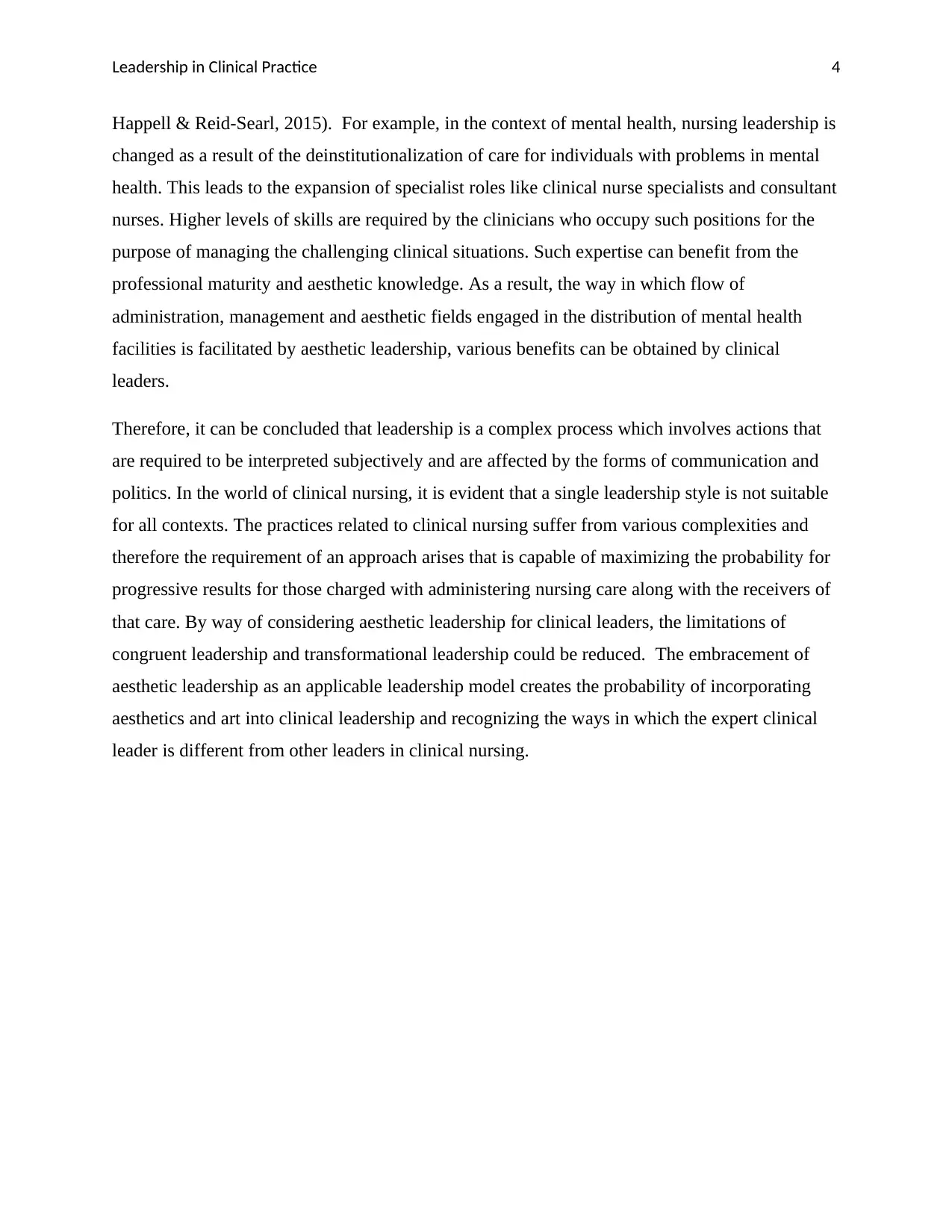
Leadership in Clinical Practice 4
Happell & Reid‐Searl, 2015). For example, in the context of mental health, nursing leadership is
changed as a result of the deinstitutionalization of care for individuals with problems in mental
health. This leads to the expansion of specialist roles like clinical nurse specialists and consultant
nurses. Higher levels of skills are required by the clinicians who occupy such positions for the
purpose of managing the challenging clinical situations. Such expertise can benefit from the
professional maturity and aesthetic knowledge. As a result, the way in which flow of
administration, management and aesthetic fields engaged in the distribution of mental health
facilities is facilitated by aesthetic leadership, various benefits can be obtained by clinical
leaders.
Therefore, it can be concluded that leadership is a complex process which involves actions that
are required to be interpreted subjectively and are affected by the forms of communication and
politics. In the world of clinical nursing, it is evident that a single leadership style is not suitable
for all contexts. The practices related to clinical nursing suffer from various complexities and
therefore the requirement of an approach arises that is capable of maximizing the probability for
progressive results for those charged with administering nursing care along with the receivers of
that care. By way of considering aesthetic leadership for clinical leaders, the limitations of
congruent leadership and transformational leadership could be reduced. The embracement of
aesthetic leadership as an applicable leadership model creates the probability of incorporating
aesthetics and art into clinical leadership and recognizing the ways in which the expert clinical
leader is different from other leaders in clinical nursing.
Happell & Reid‐Searl, 2015). For example, in the context of mental health, nursing leadership is
changed as a result of the deinstitutionalization of care for individuals with problems in mental
health. This leads to the expansion of specialist roles like clinical nurse specialists and consultant
nurses. Higher levels of skills are required by the clinicians who occupy such positions for the
purpose of managing the challenging clinical situations. Such expertise can benefit from the
professional maturity and aesthetic knowledge. As a result, the way in which flow of
administration, management and aesthetic fields engaged in the distribution of mental health
facilities is facilitated by aesthetic leadership, various benefits can be obtained by clinical
leaders.
Therefore, it can be concluded that leadership is a complex process which involves actions that
are required to be interpreted subjectively and are affected by the forms of communication and
politics. In the world of clinical nursing, it is evident that a single leadership style is not suitable
for all contexts. The practices related to clinical nursing suffer from various complexities and
therefore the requirement of an approach arises that is capable of maximizing the probability for
progressive results for those charged with administering nursing care along with the receivers of
that care. By way of considering aesthetic leadership for clinical leaders, the limitations of
congruent leadership and transformational leadership could be reduced. The embracement of
aesthetic leadership as an applicable leadership model creates the probability of incorporating
aesthetics and art into clinical leadership and recognizing the ways in which the expert clinical
leader is different from other leaders in clinical nursing.
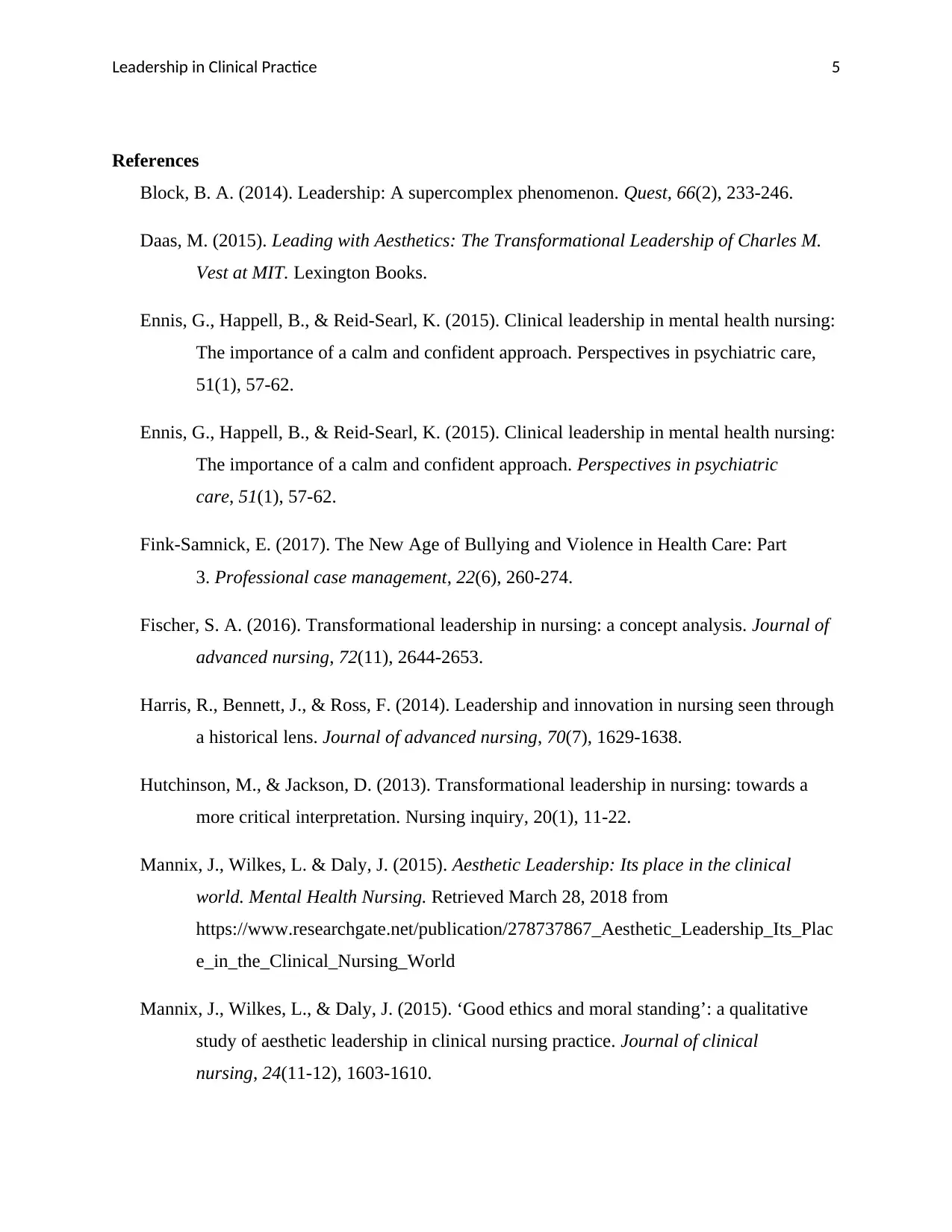
Leadership in Clinical Practice 5
References
Block, B. A. (2014). Leadership: A supercomplex phenomenon. Quest, 66(2), 233-246.
Daas, M. (2015). Leading with Aesthetics: The Transformational Leadership of Charles M.
Vest at MIT. Lexington Books.
Ennis, G., Happell, B., & Reid‐Searl, K. (2015). Clinical leadership in mental health nursing:
The importance of a calm and confident approach. Perspectives in psychiatric care,
51(1), 57-62.
Ennis, G., Happell, B., & Reid‐Searl, K. (2015). Clinical leadership in mental health nursing:
The importance of a calm and confident approach. Perspectives in psychiatric
care, 51(1), 57-62.
Fink-Samnick, E. (2017). The New Age of Bullying and Violence in Health Care: Part
3. Professional case management, 22(6), 260-274.
Fischer, S. A. (2016). Transformational leadership in nursing: a concept analysis. Journal of
advanced nursing, 72(11), 2644-2653.
Harris, R., Bennett, J., & Ross, F. (2014). Leadership and innovation in nursing seen through
a historical lens. Journal of advanced nursing, 70(7), 1629-1638.
Hutchinson, M., & Jackson, D. (2013). Transformational leadership in nursing: towards a
more critical interpretation. Nursing inquiry, 20(1), 11-22.
Mannix, J., Wilkes, L. & Daly, J. (2015). Aesthetic Leadership: Its place in the clinical
world. Mental Health Nursing. Retrieved March 28, 2018 from
https://www.researchgate.net/publication/278737867_Aesthetic_Leadership_Its_Plac
e_in_the_Clinical_Nursing_World
Mannix, J., Wilkes, L., & Daly, J. (2015). ‘Good ethics and moral standing’: a qualitative
study of aesthetic leadership in clinical nursing practice. Journal of clinical
nursing, 24(11-12), 1603-1610.
References
Block, B. A. (2014). Leadership: A supercomplex phenomenon. Quest, 66(2), 233-246.
Daas, M. (2015). Leading with Aesthetics: The Transformational Leadership of Charles M.
Vest at MIT. Lexington Books.
Ennis, G., Happell, B., & Reid‐Searl, K. (2015). Clinical leadership in mental health nursing:
The importance of a calm and confident approach. Perspectives in psychiatric care,
51(1), 57-62.
Ennis, G., Happell, B., & Reid‐Searl, K. (2015). Clinical leadership in mental health nursing:
The importance of a calm and confident approach. Perspectives in psychiatric
care, 51(1), 57-62.
Fink-Samnick, E. (2017). The New Age of Bullying and Violence in Health Care: Part
3. Professional case management, 22(6), 260-274.
Fischer, S. A. (2016). Transformational leadership in nursing: a concept analysis. Journal of
advanced nursing, 72(11), 2644-2653.
Harris, R., Bennett, J., & Ross, F. (2014). Leadership and innovation in nursing seen through
a historical lens. Journal of advanced nursing, 70(7), 1629-1638.
Hutchinson, M., & Jackson, D. (2013). Transformational leadership in nursing: towards a
more critical interpretation. Nursing inquiry, 20(1), 11-22.
Mannix, J., Wilkes, L. & Daly, J. (2015). Aesthetic Leadership: Its place in the clinical
world. Mental Health Nursing. Retrieved March 28, 2018 from
https://www.researchgate.net/publication/278737867_Aesthetic_Leadership_Its_Plac
e_in_the_Clinical_Nursing_World
Mannix, J., Wilkes, L., & Daly, J. (2015). ‘Good ethics and moral standing’: a qualitative
study of aesthetic leadership in clinical nursing practice. Journal of clinical
nursing, 24(11-12), 1603-1610.
⊘ This is a preview!⊘
Do you want full access?
Subscribe today to unlock all pages.

Trusted by 1+ million students worldwide
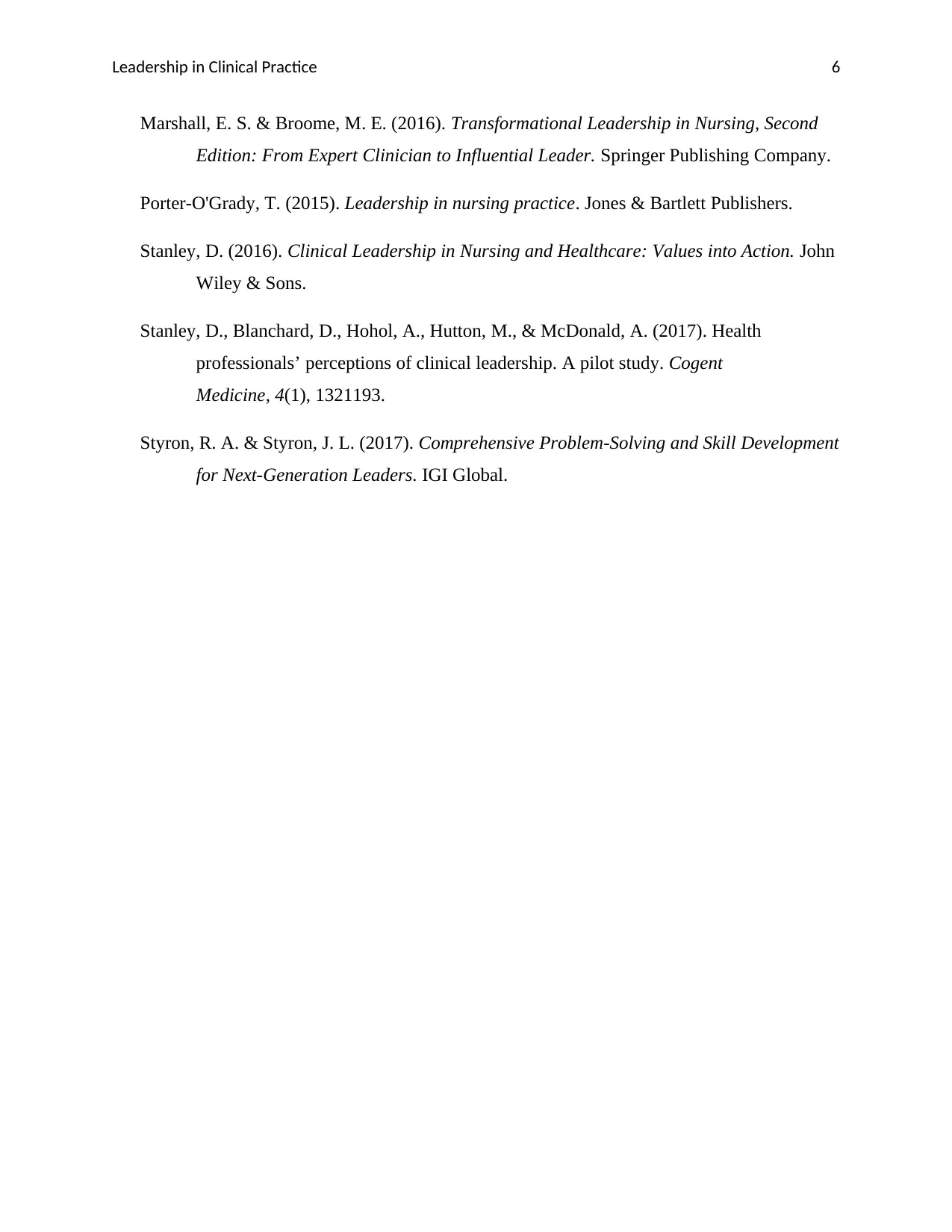
Leadership in Clinical Practice 6
Marshall, E. S. & Broome, M. E. (2016). Transformational Leadership in Nursing, Second
Edition: From Expert Clinician to Influential Leader. Springer Publishing Company.
Porter-O'Grady, T. (2015). Leadership in nursing practice. Jones & Bartlett Publishers.
Stanley, D. (2016). Clinical Leadership in Nursing and Healthcare: Values into Action. John
Wiley & Sons.
Stanley, D., Blanchard, D., Hohol, A., Hutton, M., & McDonald, A. (2017). Health
professionals’ perceptions of clinical leadership. A pilot study. Cogent
Medicine, 4(1), 1321193.
Styron, R. A. & Styron, J. L. (2017). Comprehensive Problem-Solving and Skill Development
for Next-Generation Leaders. IGI Global.
Marshall, E. S. & Broome, M. E. (2016). Transformational Leadership in Nursing, Second
Edition: From Expert Clinician to Influential Leader. Springer Publishing Company.
Porter-O'Grady, T. (2015). Leadership in nursing practice. Jones & Bartlett Publishers.
Stanley, D. (2016). Clinical Leadership in Nursing and Healthcare: Values into Action. John
Wiley & Sons.
Stanley, D., Blanchard, D., Hohol, A., Hutton, M., & McDonald, A. (2017). Health
professionals’ perceptions of clinical leadership. A pilot study. Cogent
Medicine, 4(1), 1321193.
Styron, R. A. & Styron, J. L. (2017). Comprehensive Problem-Solving and Skill Development
for Next-Generation Leaders. IGI Global.
1 out of 7
Related Documents
Your All-in-One AI-Powered Toolkit for Academic Success.
+13062052269
info@desklib.com
Available 24*7 on WhatsApp / Email
![[object Object]](/_next/static/media/star-bottom.7253800d.svg)
Unlock your academic potential
Copyright © 2020–2025 A2Z Services. All Rights Reserved. Developed and managed by ZUCOL.





